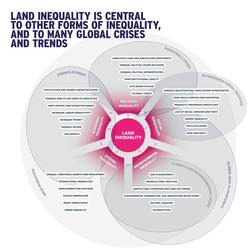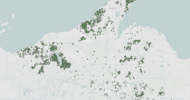ILC | 24 November 2020
A new report reveals land inequality is worse than we thought and is fuelling other inequalities
In a new study released on 24 November 2020, researchers say that land inequality is rising in most countries. What is worse, new results prove that land inequality is significantly higher than previously recorded, with current data showing a 41 percent increase compared to traditional census data.
The report, Uneven Ground: land inequality at the heart of unequal societies, is the first of its kind, shedding new light on the scale and speed of this growing phenomenon and providing the most comprehensive picture available today. The report was informed under a wide partnership led by the International Land Coalition, of which CIRAD is a member, and in close collaboration with Oxfam.
“In the framework of this project, a new way to measure land inequality was developed that goes beyond land size distribution captured through traditional agricultural censuses ”, said Ward Anseeuw, researcher at CIRAD, co-author of the report and coordinator of the initiative.
Historically, methods to measure land inequality excluded vital pieces of information, such as the value of land, multiple ownership and landlessness, as well as the control a person or an entity has over those factors.
“These findings radically alter our understanding of the extent and far reaching consequences land inequality has, proving that not only is it a bigger problem than we thought but it’s undermining the stability and development of sustainable societies ”, Anseeuw added.
Blatant and growing land inequalities
New measurements show that the top 10 percent of the rural population captures 60 percent of agricultural land value, while the bottom 50 percent of the rural population controls just 3 percent of land value .
The study finds that land inequality directly threatens the livelihoods of an estimated 2.5 billion people involved in smallholder agriculture , as well the world’s poorest 1.4 billion people, most of whom depend largely on agriculture for their livelihoods.
And the trend is upward. Global inequality experts blame the upward trend of land inequality partly on the increased interest from corporate and financial actors, such as investment funds, in agricultural land investments. As corporate and financial investments grow, ownership and control of land becomes more concentrated and increasingly opaque.
Today, the largest 1 percent of farms operate more than 70 percent of the world’s farmland and are integrated into the corporate food system, while over 80 percent are smallholdings of less than two hectares that are generally excluded from global food chains. This phenomenon has even reached European shores with less than 3 percent of farms now accounting for more than half of the farmed land in the EU .
If not addressed and if the trend continues, increasing land inequality will have significant negative consequences for all societies, on economic and social development, on the environment and on democracy and peace. Yet the authors insist that land concentration is not inevitable.
The solutions, however, require a profound transformation of power relations and political, economic, social and legal norms. The report encourages, to name but a few, democratization of land governance, a strengthening of land-related regulation, full transparency of land holdings, true recognition of minority rights, and finally government support towards equitable and sustainable agricultural production models.














